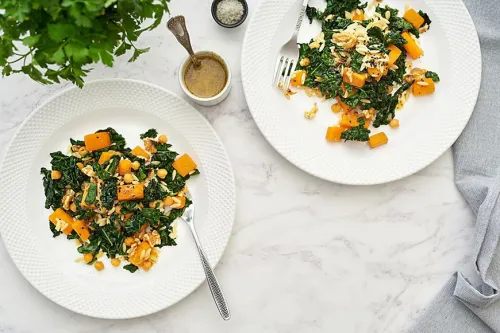Discovering a giant pimple is definitely an unwelcome surprise, but at least I know that I have an arsenal of products and lifetime of tips to tame breakouts fast(ish). In my opinion, it’s almost worse to wake up with facial redness—the kind that no amount of BB cream or foundation can cover up—since it’s a constant battle that I never really know how to fight.
Relatable? Well, if the skin-calming effects of your serums and spa treatments feel fleeting, it’s because taming a crimson complexion often starts internally. “The skin is an external road map of what’s happening inside your body,” explains Corina Crysler, clinical nutritionist and owner of Moonshine Juicery. “Redness is mainly an indicator of long-term or chronic inflammation.”
The main culprits of angry skin are things that most of us experience on some level: Stress (both lifestyle and environmental), lack of sleep, and—this one’s key—a less-than-ideal diet. Inflammatory foods, deficiency in essential nutrients, dehydration, and allergic reactions can all contribute to redness, rashes, and broken capillaries, Crysler says.
Luckily, making a few simple tweaks to your grocery list can reduce the amount of inflammation in your body—and you’ll likely be able to see the effects on your face. Here, Crysler shares the best foods to eat and avoid for a calm, even complexion. Because, really, the only fiery thing on your face should be your go-to red lipstick.
Suffering from a perpetually ruddy face? Read on for some food tips that may help you find relief.

What not to eat if you’ve got chronically flushed skin
Since diet plays such a large role in skin health, Crysler first recommends cutting out foods that are closely linked to inflammation. “Dairy is typically the worst one,” she says. “Even a little bit can create a reaction in the body.” (As anyone who breaks out at the mere sight of Brie can attest.)
This Parisian Skincare Brand Is Launching in the United States for the First Time—Here’s What a Derm Wants You to Know

We’re Calling It: Cleansing Balms Are the Face Wash of the Future—Here Are 3 to Add to Your Cart

This Is the One Product That Scarlett Johansson Always Keeps in Her Purse and on Her Bedside Table

You should also banish highly processed foods from your grocery cart, Crysler says. “Refined sugars can challenge the immune system,” she points out. “Refined, bleached flours that are genetically modified and foods with high sodium and artificial additives should be avoided as well.” But you knew that already, right?

The best foods for managing skin redness
So, what should you eat to calm stressed-out skin? Crysler recommends a well-balanced, mostly plant-based diet. “Whole grains, lots of veggies and fruit, and plant-based proteins [can] reduce redness,” she says. Eating organic whenever possible is a bonus, adds Crysler, as it can help minimize the overall toxin load on your body.
According to the nutritionist, these are the anti-inflammatory ingredients you should be eating on the reg:
- Healthy fats such as nuts, seeds, and avocado—many of which come with multiple benefits. “Brazil nuts and pumpkin seeds are high in selenium and other minerals that provide cellular health,” Crysler points out.
- Alkaline foods like fennel, celery and cucumber. “They’re cooling and help with excess heat in the body,” says Crysler.
- Nutrient-dense veggies—squash, beets, dark leafy greens, mung beans, lemons, garlic, onions, ginger, and turmeric, to name a few.
- Antioxidant- and enzyme-rich fruits, such as pineapple, kiwi, and papaya.
- Green and beet-based juices—preferably cold-pressed. “Beets and dark green veggies help rid toxins from the body,” says Crysler.
- Herbal teas like peppermint, parsley, and dandelion root
- Fiber-packed whole grains, such as brown rice, millet, whole oats, and quinoa. “They all provide essential amino acids and minerals for healthy connective tissues,” Crysler says.

The next-level solution for inflamed skin
For particularly stubborn redness, Crysler suggests a gentle liver cleanse. “The liver has to be addressed when someone has chronic inflammation,” she says.
To try this at home, load up on the ingredients above while avoiding alcohol and limiting your coffee intake. Instead, hydrate with herbal teas and organic green and beet juices—and lots of water, of course. Crysler also suggests eating smaller and more frequent meals than you’re used to, which is said to be helpful for digesting food and absorbing nutrients. “The easiest thing is to keep your overall food choices super simple,” says the nutritionist “Once the redness is under control you can ease up a bit, but not too much.” Before you know it, things will start looking a lot rosier—with the exception of your cheeks, that is.
Whip up one of these five healthy tonics to fight inflammation from the inside out. Then, heed these tips from Well+Good Council member Candice Kumai.
Sign Up for Our Daily Newsletter
Get all the latest in wellness, trends, food, fitness, beauty, and more delivered right to your inbox.
Got it, you've been added to our email list.








